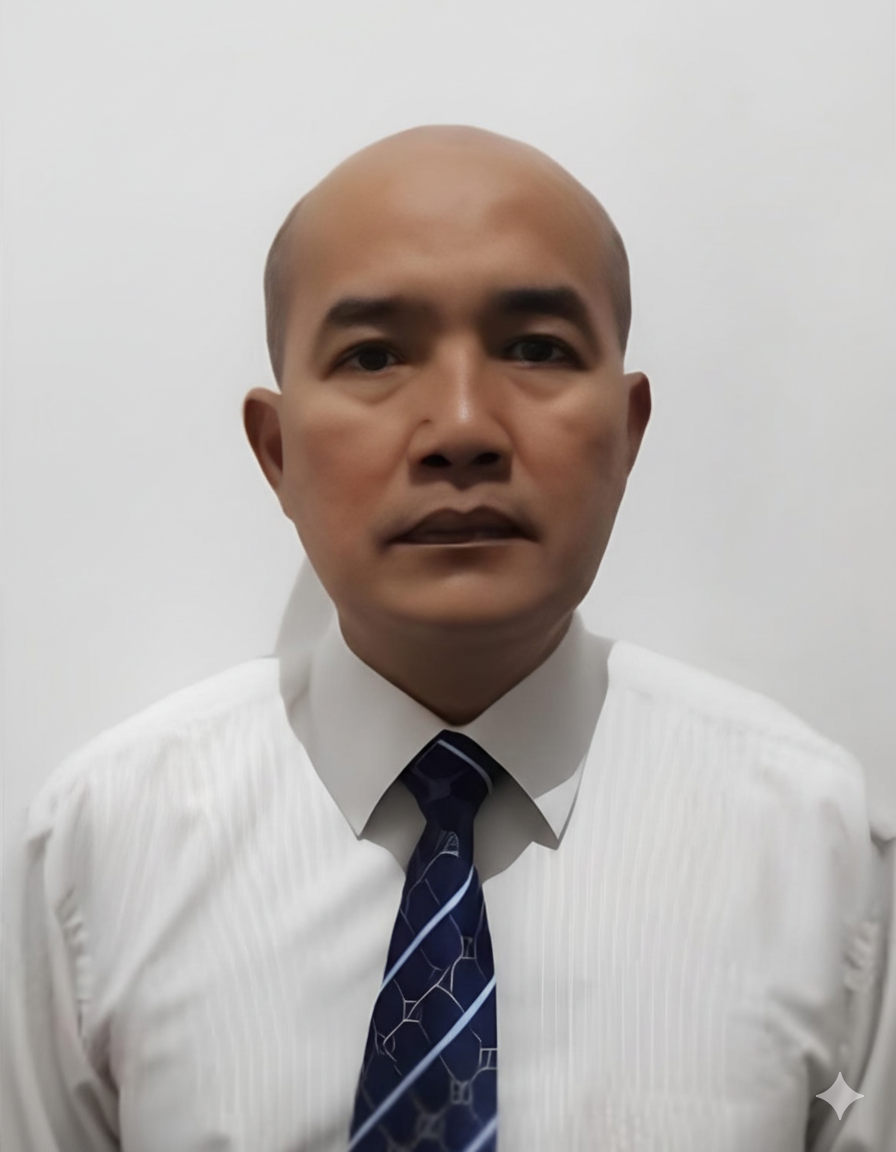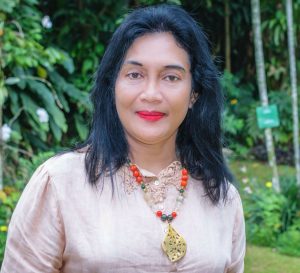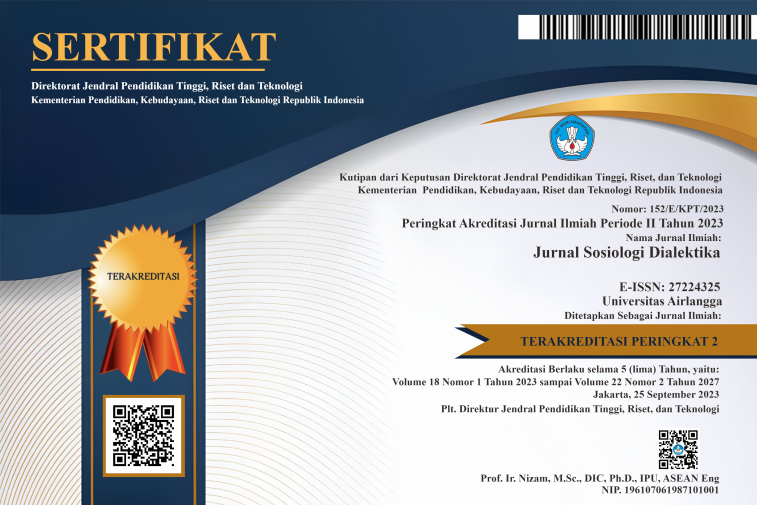The struggle of Tengger Tribal youths using higher education to get social and cultural status in society
Downloads
The enrollment rate for the higher education of the Tengger tribe is low. However, there is a group of Tengger youths who have the determination to achieve a Bachelor's degree despite the limitations that they encounter. This study aimed to describe the meaning of education among the Tengger tribe and the efforts of the Tengger youths to continue their studies in college. This study was conducted in Ngadiwono Village Pasuruan Regency in the East Java Province and using a qualitative method. The data is analyzed by social and cultural reproduction theory by Pierre Bourdieu. The data was obtained from bachelor students and people from the older community group in order to find out the meaning of education based on their understanding. The data was collected using interviews, observations and documentation methods. The results of this study show that the success of the youths in becoming undergraduates was due to their effort and hard work. They were supported by their families who had a better understanding of the meaning of education. They have a social modal that they got from elementary education. They develop their social capital to get better education and occupations in the future.
Adi NL (2018) Gunung Bromo sebagai destinasi wisata alam di Probolinggo (domestic case study). Thesis, Sekolah Tinggi Pariwisata Ambarrukmo, Yogyakarta.
Anas M (2013) Telaah metafisik upacara Kasada, mitos dan kearifan local hidup dalam masyarakat Tengger. Kalam: Jurnal Studi Agama dan PEmikiran Islam 7 (1): 21-52.
Arnawan G (2016) Faktor penyebab kurangnya minat remaja desa terhadap pendidikan di perguruan tinggi (studi kasus pada remaja di Desa Balirejo Kecamatan Angkona Kabupaten Luwu Timur). Jurnal Sosialisasi Pendidikan Sosiologi 3 (3):80-84.
Arslan E (2018) Migration, habitus and symbolic order: Reflecting on a multilingualism project at a German University. Power and Education 10 (1):71-91.
Bourdieu P (2013) Outline of a Theory of Practice. UK: Cambridge University Press.
Brewer JD (2001) Ethnography. Philadelphia: Open University Press.
Budirahayu T (2016) Problema Pendidikan di Indonesia (Studi Kritis Sosiologi Pendidikan) Yogyakarta: Azza Grafika.
Goodall HL (1991) Living in the Rock N Roll Mystery: Reading Context, Self, and Others as Clues. Carbondale: Southern Illinois University Press.
Harker R, Cheelen M & Wilkes C (2005) Habitus X Modal + Ranah = Praktik (Pengantar Paling Komprehensif kepada Pemikiran Pierre Bourdieu). Yogyakarta: Jalasutra.
Haryanto JT (2016) Harmonious messages on the folklore of Tengger community in Ngadas Village, Malang Indonesia. Jurnal SMaRT 2 (2):131-142.
Hefner RW (1999) Geger Tengger (Perubahan Sosial dan Perkelahian Politik). Yogyakarta: LKIS.
Hidayat (2017) Wajah-Wajah Kalah: Kisah Penyingkiran Masyarakat Tengger. [Accessed 15 November 2020].
https://geotimes.co.id/opini/wajah-wajah-kalah-kisah-penyingkiran-masyarakat-tengger/
Hisyam MA & Kamarudin WAZ (2015) Harmoni lintas agama masyarakat Tengger. ISLAMICA: Jurnal Studi Keislaman 10 (1):82-107.
Huda MT (2019) Peran budaya dalam membangun hubungan antara umat beragama di Suku Tenger. PALITA: Journal of Social-Religion Research 4 (1):13-30.
Jacky M (2015) Buku Sosiologi (Konsep, Teori, dan Metode). Jakarta: Mitra Wacana Media.
Larasati RS (2018) Success as social: Exploring young people's understandings of success in rural Java. Thesis, Victoria University of Wellington, Wellington.
Maksum A (2015) Politik identitas masyarakat Tengger dalam memperhatikan system kebudayaan dari hegemoni Islam dan kekuasaan. el Harakah 17 (1):18-35.
Manggala HDA (2019) Perubahan sosial di Tosari (studi kasus lunturnya folklore masyarakat Desa Tosari, Kecamatan Tosari, Kabupaten Pasuruan). Thesis, Universitas Sebelas Maret, Surakarta).
Marzuki A (2016) Nilai pendidikan Islam dalam tradisi Unan-unan masyarakat suku Tengger. Al-Murabbi 1 (2):217-242.
Nash R (1990) Bourdieu on education and social and cultural reproduction. British Journal of Sociology of Education 11 (4):431-447.
Nashihuddin W (2019) Perspektif etnografi baru, riset budaya, audiens, dan genealogy dalam cultural studies. Thesis, Universitas Gadjah Mada, Yogyakarta.
Nguyen TD (2016) Social reproduction in Vietnam: Educational attainment, employment. International Journal of Educational Development 51:10-22.
Pradikto S, Mochamad T & Laili I (2014) Persepsi masyarakat di lingkungan industri untuk melanjutkan ke perguruan tinggi. Jurnal Ilmiah Edukasi & Sosial 5 (1): 90-101.
Prasetia H, Muhari & Wspodo TS (2019) Pengaruh pembelajaran berbasis masalah terhadap pemahaman siswa mengenai hak dan kewajiban siswa sekolah dasar sebagai warga negara. Jurnal Review Pendidikan Dasar: Jurnal Kajian Pendidikan dan Hasil Penelitian 5 (2):1-9.
Sari IN (2013) Identifikasi elemen-elemen pementuk ruang pemukiman masyarakat suku Tengger Dusun Ngadas berdasarkan sistem kepercayaan. Thesis, Institut Teknologi Nasional, Malang.
Serna GR & Woulfe R (2017) Social reproduction and college access: Current evidence, context, and potential alternatives. Critical Questions in Education 8 (1):1-16.
Sidiq (2018) Etnografi: Pengertian, Contoh & Metode Penelitian. [Accessed 13 May 2020]. http://sosiologis.com/etnografi
Siregar M (2016) Teori "gado-gado” Pierre-Felix Bourdieu. Jurnal Studi Kultural 1 (2):79-82.
Swartz D (1997) Culture and Power: Sociology of Pierre Bourdieu. Chicago: University of Chicago Press.
Syakir (2016) Seni perbatikan Semarang: Tinjauan analitik prespektif Bourdieu pada praksis arena produksi kultural. Jurnal Imajinasi 10 (2):121-132.
Toyibah D (2017) Habitus, agency and political participation of female students: A study at Islamic university in Indonesia. Makara Hubs-Asia 21 (2):113-121.
1. Copyright of this journal is possession of Editorial Board and Journal Manager, by the knowledge of author, whilst the moral right of the publication belongs to the author.
2. Legal formal aspect of journal publication accessibility refers to Creative Commons Attribution-NonCommercial-ShareAlike (CC BY-NC-SA), implies that publication can be used for non-commercial purposes in its original form (cannot be modified).
3. Every publications (printed/electronic) are open access for educational purposes, research, and library. Other that the aims mentioned above, editorial board is not responsible for copyright violation.















